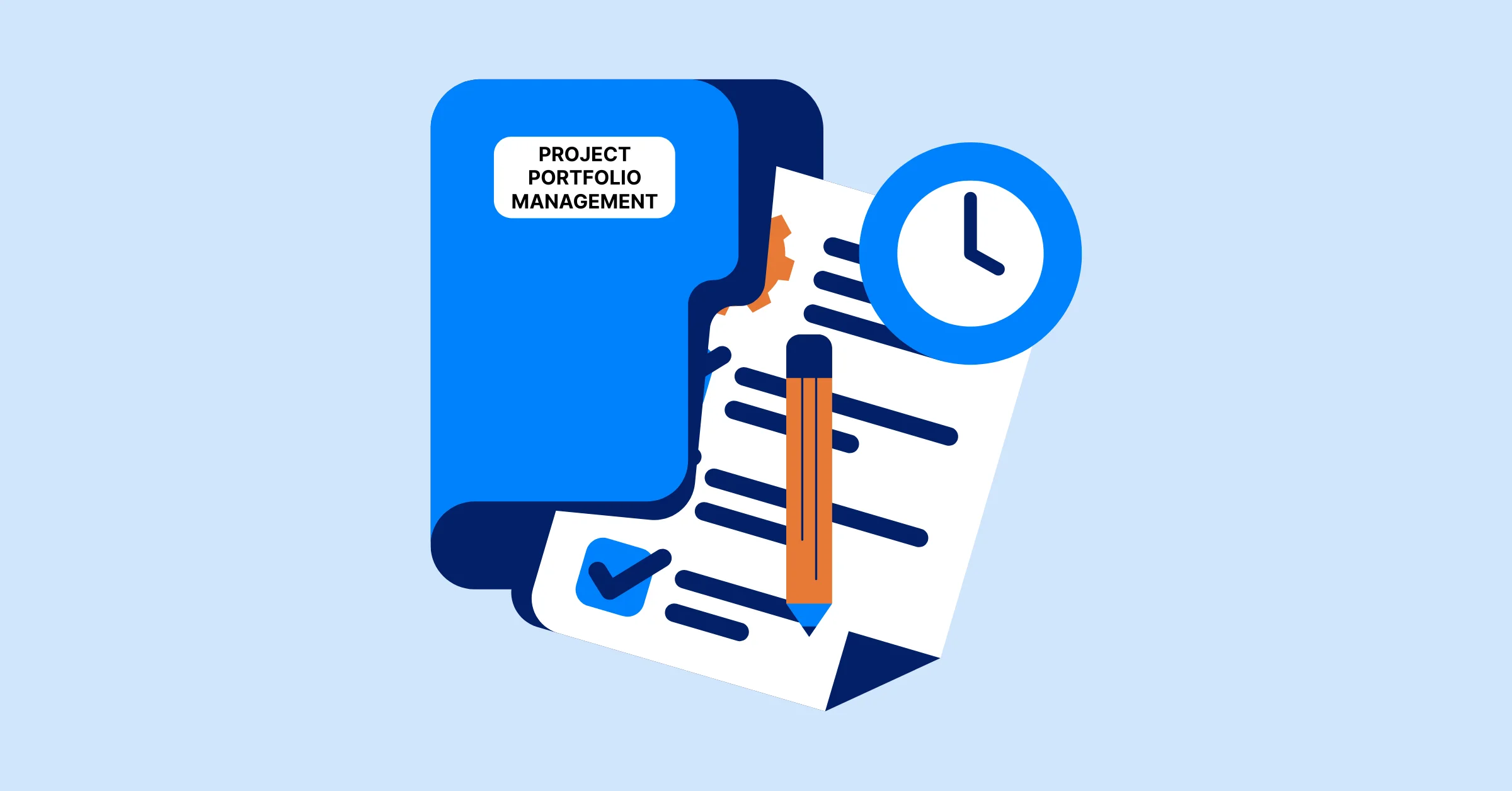The 5 Phases of Well-Defined Construction Project Management
Explore the five key phases of construction project management and how TaskFord ensures control over cost, schedule, and quality for successful project delivery
Construction project management is both an art and a science. It involves coordinating people, materials, equipment, and finances to turn architectural concepts into tangible structures. From skyscrapers and bridges to residential housing and infrastructure, every successful project follows a clear process built on discipline, documentation, and control. Without that structure, even the most promising projects risk cost overruns, schedule delays, and quality failures.
To manage the complexity of modern construction, project managers rely on a standardized framework divided into five core phases: Initiation, Planning, Execution, Monitoring & Control, and Closing. Each phase has distinct objectives and deliverables, but together they ensure that time, cost, and quality stay balanced. In this guide, we’ll explore each phase in depth, outline key success metrics, and show how digital tools such as TaskFord can enhance efficiency throughout the entire lifecycle of construction project management.
What Is Construction Project Management?
Construction project management is the process of planning, coordinating, and supervising a construction project from start to finish. It involves managing timelines, budgets, quality, and safety while ensuring all contractors and stakeholders stay aligned.
Unlike general project management and other types of projects, it requires technical knowledge of building methods, compliance with safety and legal standards, and close coordination among architects, engineers, and suppliers. The goal is simple: deliver a structure that meets design expectations, stays within budget, and finishes on schedule.
The 5 Phases of Well-Defined Construction Project Management
Phase 1: Initiation
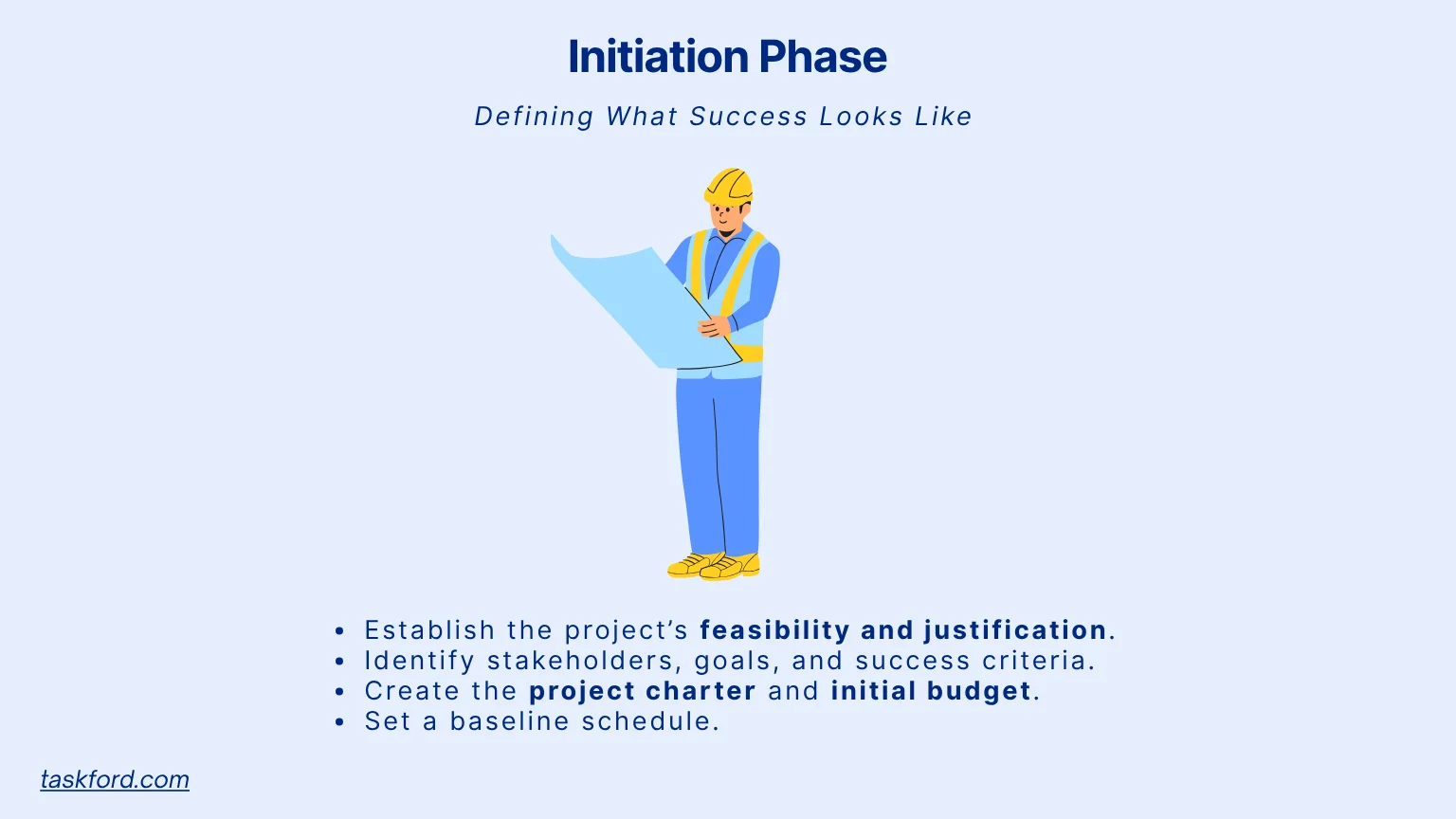
The initiation phase marks the official start of a construction project. It is where feasibility and justification are established and where the groundwork for all future phases is laid.
Before any physical work begins, the project team defines why the project should exist and whether it is technically and financially viable. This phase often overlaps with pre-construction activities, such as site evaluation, regulatory review, and budget assessment.
Key activities include:
- Conducting feasibility studies and identifying potential risks.
- Performing early cost-benefit analysis to confirm financial viability.
- Completing stakeholder analysis to identify priorities and potential conflicts.
- Preparing a project charter that outlines goals, scope, responsibilities, and expected outcomes.
- Developing an initial baseline schedule and budget to serve as performance benchmarks later.
A well-executed initiation phase results in a clearly defined project scope and formal authorization to proceed. Without this foundation, later phases risk misalignment between expectations, resources, and results.
Phase 2: Planning
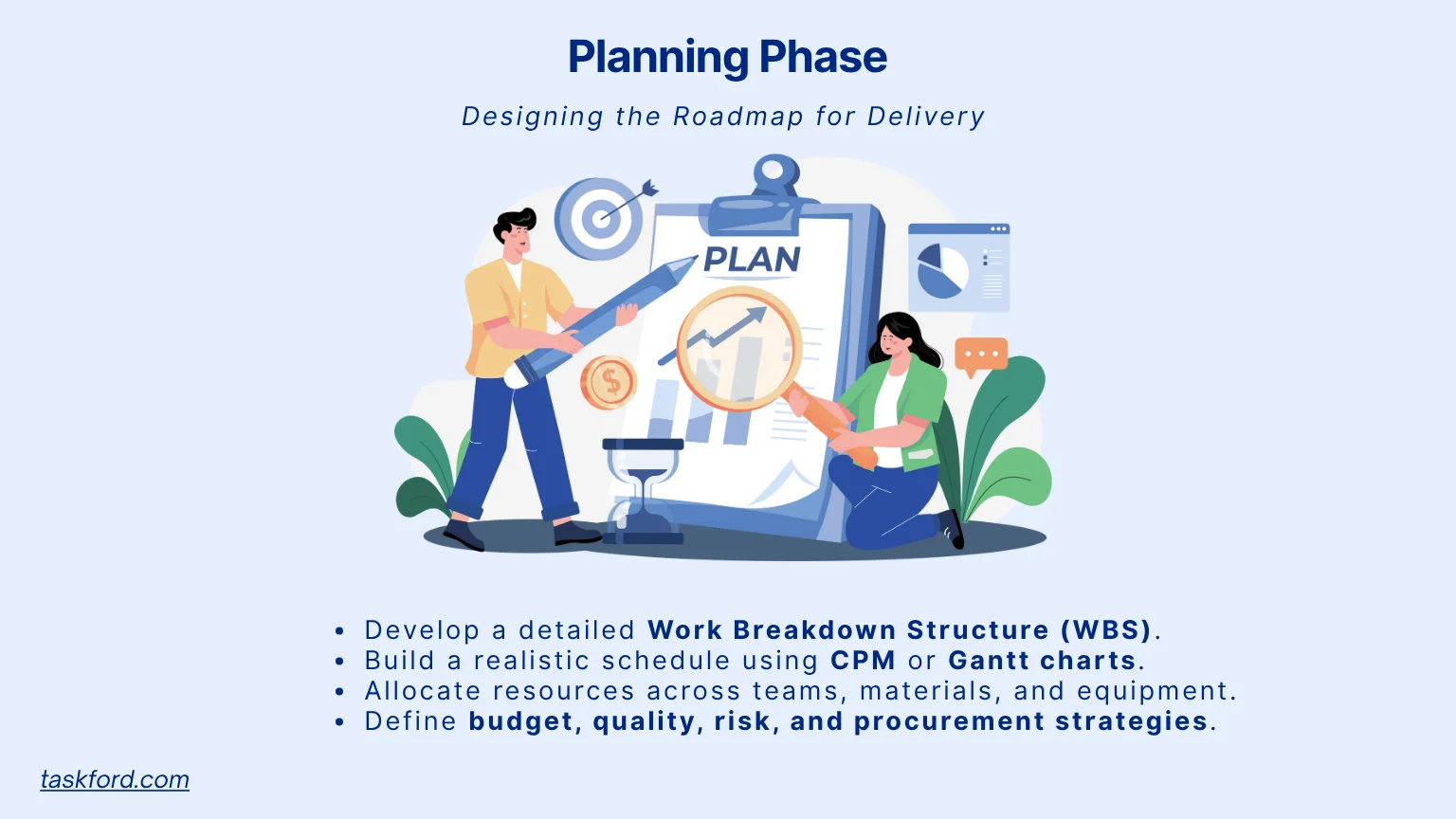
The planning phase is the most intensive and arguably the most critical. It transforms high-level objectives into a detailed roadmap that guides execution and monitoring.
During this stage, project managers, engineers, and consultants work together to define the scope, allocate resources, and establish how progress will be measured.
Core activities include:
- Developing a Work Breakdown Structure (WBS) that breaks the project into manageable components.
- Creating a comprehensive project schedule using techniques such as Critical Path Method (CPM) or Gantt charts.
- Allocating labor, materials, and equipment efficiently across tasks.
- Preparing a detailed budget based on the baseline estimate.
- Planning for procurement, quality control, and Health, Safety, and Environmental (HSE) compliance.
- Establishing a risk management plan to anticipate potential disruptions.
The planning phase is where construction project management tools are first introduced. These platforms help teams visualize dependencies, assign tasks, and track upcoming milestones.
A robust plan ensures efficiency in the later stages. The more comprehensive the plan, the fewer surprises arise on site. At the end of this phase, the team should have a fully developed project management plan, complete with schedule, cost, and risk baselines.
Phase 3: Execution
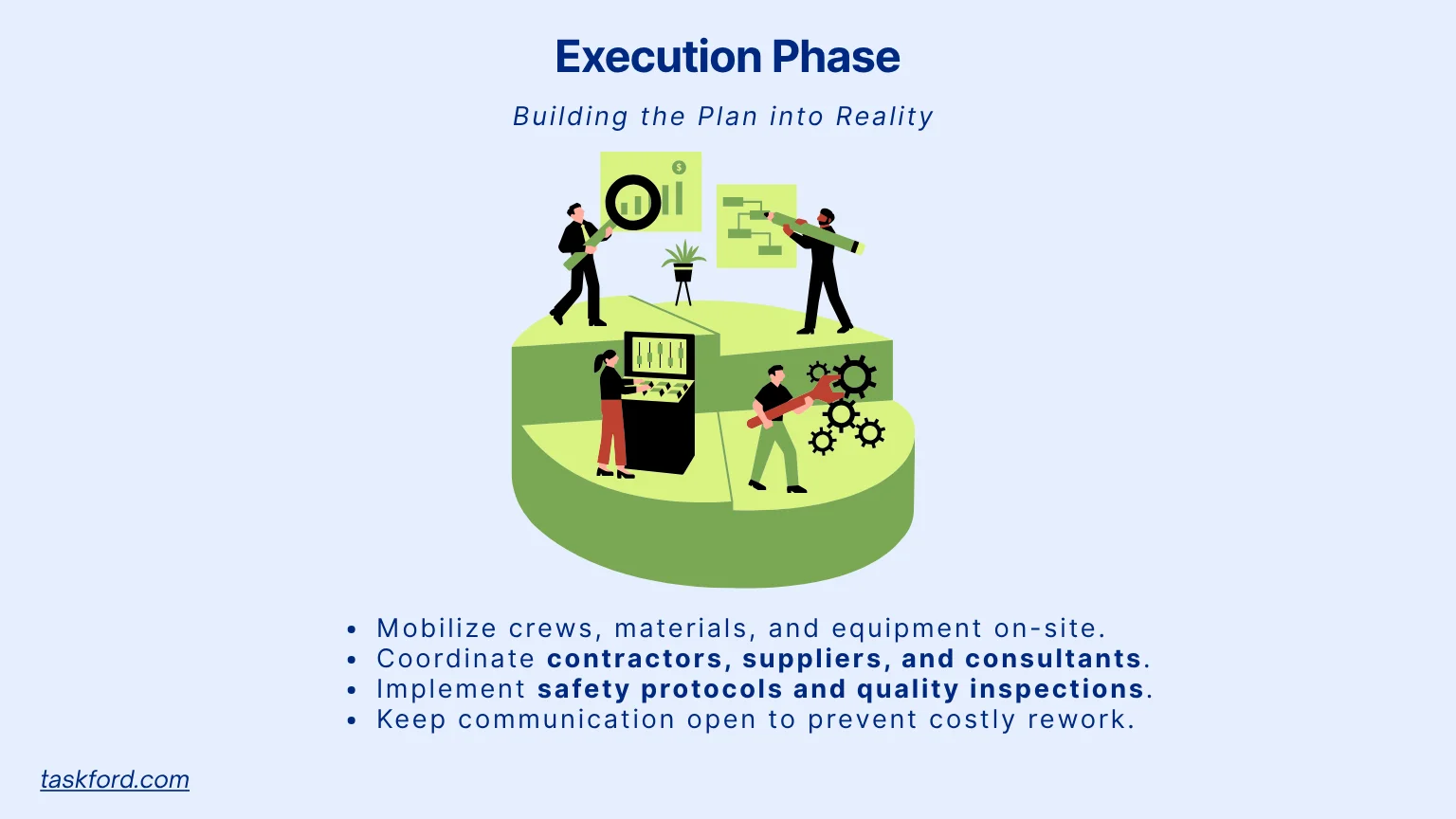
The execution phase is where plans take shape and physical work begins. All the preparation and documentation developed earlier are put into action.
Activities during execution include:
- Mobilizing teams, setting up the site, and deploying equipment.
- Managing contractors, subcontractors, suppliers, and consultants.
- Implementing safety procedures and environmental safeguards.
- Conducting routine inspections to maintain quality standards.
- Coordinating logistics for materials and resources.
This phase demands constant leadership and clear communication. A single misunderstanding can cause rework or costly delays. Construction projects often involve multiple trades and disciplines, which means that scheduling and coordination are critical to success.
Execution is also iterative with the Monitoring & Control phase. Progress is continuously tracked, compared against the baseline, and adjusted when necessary. The ability to adapt quickly to unforeseen challenges such as weather, material shortages, or design changes is what separates strong project managers from reactive ones.
Phase 4: Monitoring and Controlling

Monitoring and controlling ensures that performance stays aligned with the original plan. This phase runs concurrently with execution and provides the analytical backbone of the project.
Managers use data-driven techniques to measure progress, identify deviations, and implement corrective actions before small issues escalate.
Key focus areas include:
- Tracking Earned Value (EV), Schedule Performance Index (SPI), and Cost Performance Index (CPI) to assess cost and time efficiency.
- Reviewing actual versus planned performance to forecast completion dates and costs.
- Managing documentation and maintaining version control to prevent miscommunication.
- Conducting regular safety and quality audits.
- Handling scope changes through structured change control processes.
This phase reinforces proactive management. Instead of reacting to problems after they occur, teams anticipate and address potential risks early. For example, by analyzing SPI and CPI trends, project managers can detect delays or cost overruns before they become critical.
Monitoring also provides stakeholders with visibility. Transparent reporting builds trust among clients, consultants, and contractors and allows for data-informed decision-making.
Phase 5: Closing
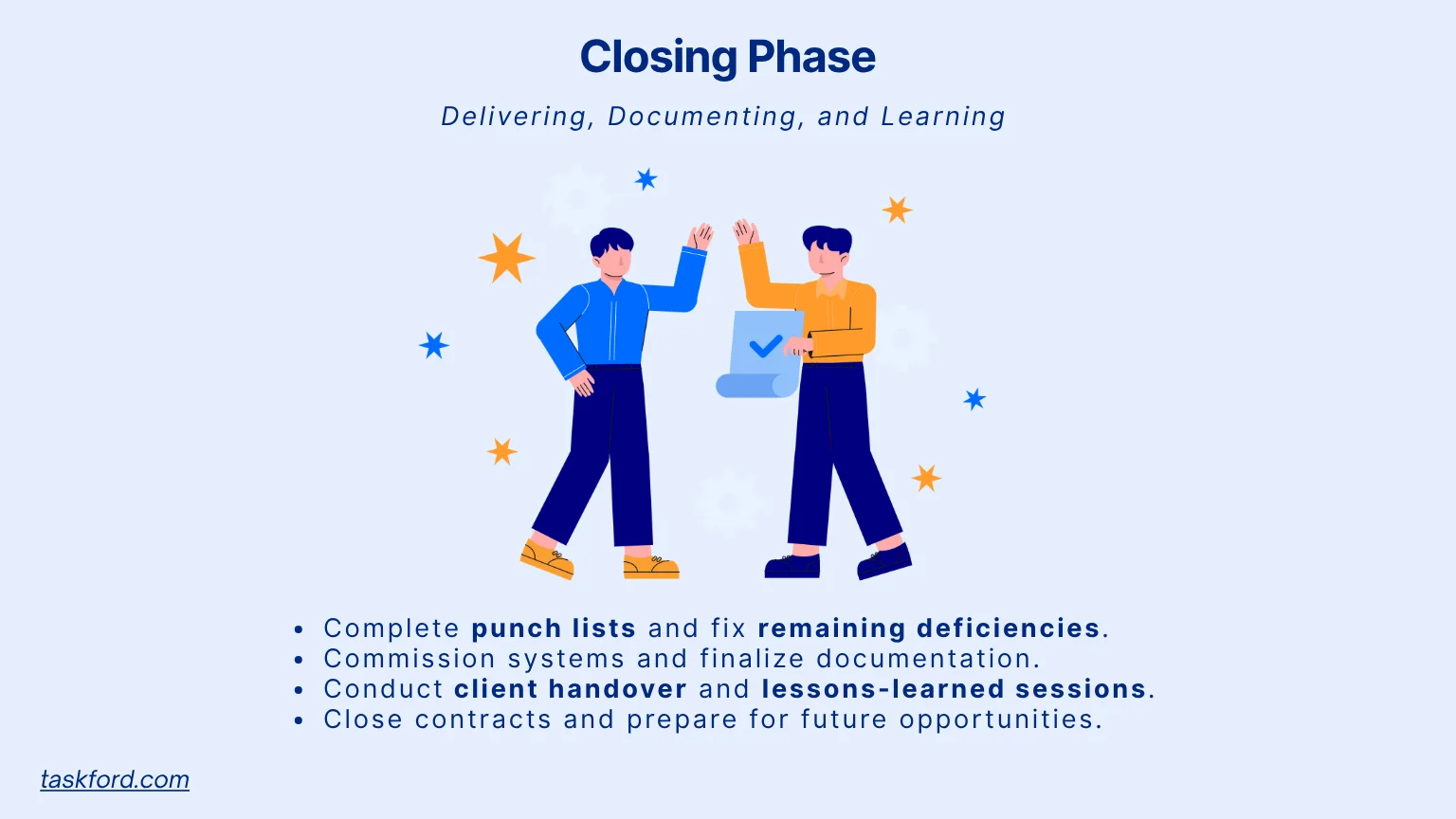
The closing phase represents the formal completion of a project. It is where deliverables are validated, final payments are processed, and lessons are documented for future improvement.
Closing should not be rushed. When planned properly from the start, it ensures smooth handover and client satisfaction.
Core activities include:
- Completing punch lists and resolving outstanding deficiencies.
- Testing and commissioning systems to verify performance.
- Conducting client walkthroughs and securing occupancy certification.
- Finalizing documentation, including as-built drawings and warranties.
- Performing post-project evaluations and lessons-learned sessions.
- Closing contracts and demobilizing resources.
Effective close-out ensures all contractual obligations are met and that knowledge is preserved. It also opens opportunities for future collaborations, especially if post-construction maintenance or support services are offered.
Extending the Construction Project Lifecycle
While the five-phase model defines the standard structure of construction project management, many organizations view the process more broadly.
Two additional stages (pre-award and post-construction services) often complete the lifecycle. The pre-award stage covers bidding, proposal development, and contract negotiation, while the post-construction stage focuses on maintenance, warranties, and client support.
Including these stages strengthens long-term relationships and creates opportunities for repeat business. Many types of projects, from residential complexes to industrial facilities, benefit from this lifecycle perspective, as it ensures continuity of service and quality beyond handover.
Key Metrics for Construction Project Management Success
No construction project can be managed effectively without measurable indicators. Metrics transform raw activity into actionable insight, helping teams evaluate performance and make informed adjustments.
Common performance metrics include:
- Cost Performance Index (CPI): Measures cost efficiency by comparing earned value to actual costs.
- Schedule Performance Index (SPI): Evaluates how closely progress follows the planned schedule.
- Earned Value (EV): Quantifies how much work has been completed relative to the plan.
- Defect Rate: Monitors quality and identifies recurring issues that require process improvement.
- Safety Incidents: Tracks compliance with health and safety standards, a critical factor in construction.
- Client Satisfaction and Change Order Frequency: Reflects the quality of communication and scope management.
Tracking these metrics regularly allows project managers to forecast trends, anticipate risks, and maintain transparency with stakeholders. Many advanced tools automatically calculate and visualize these indicators, making it easier to maintain control across complex projects.
Integrating Digital Tools in Construction Project Management
Digital transformation has changed how construction projects are managed. From scheduling to cost tracking, construction project management tools have streamlined what used to be manual and error-prone processes.
One of the most comprehensive platforms for managing these complexities is TaskFord, which centralizes key project data in a single environment. Key TaskFord features include:
- Unified Dashboard: Consolidates project timelines, cost data, and resource allocations for real-time visibility.
- Gantt Charts and Task Boards: Provide dynamic visualization of dependencies and progress across multiple workstreams.

- Resource Management: Track the utilization of labor and capacity with precision.

- Real-Time Reporting: Automatically updates metrics to monitor performance and understand insights.
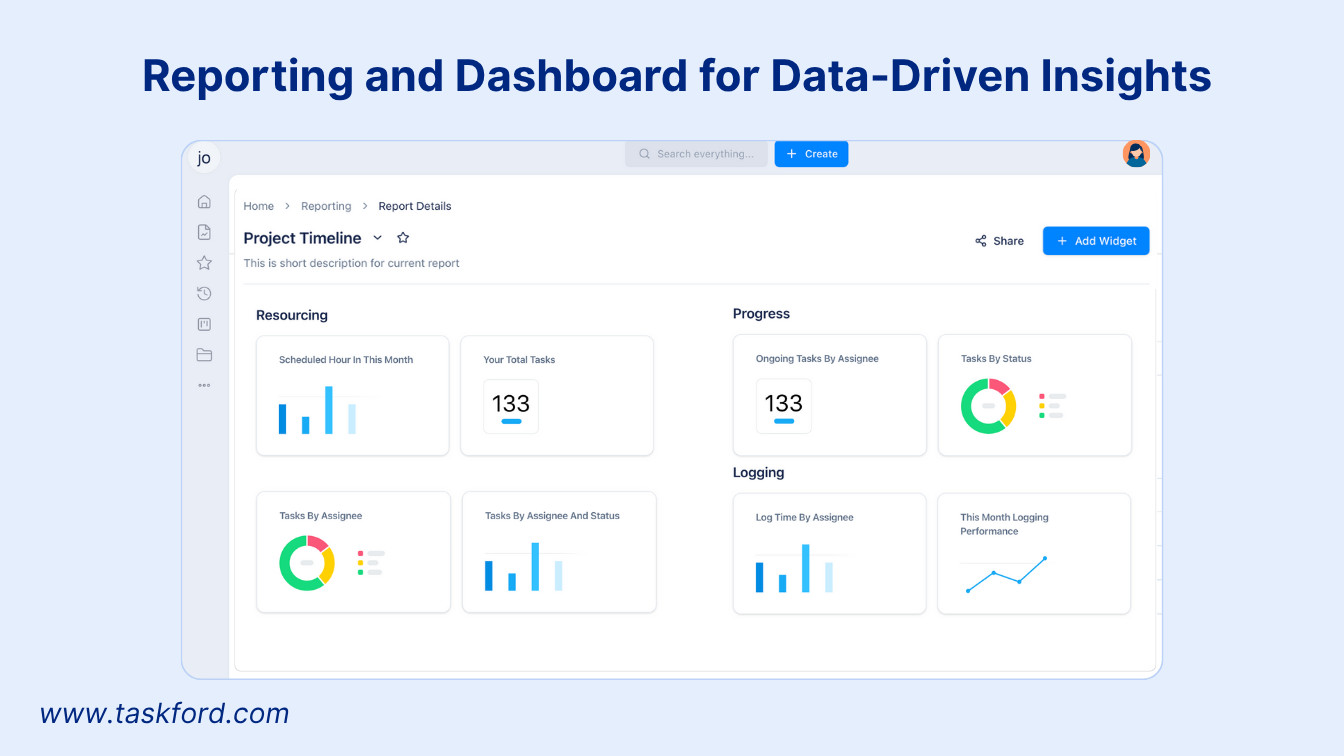
- Collaboration and Documentation: Enables seamless communication between contractors, suppliers, and consultants with version-controlled files and shared updates.
TaskFord supports every stage of construction project management, from defining baselines during initiation and planning, to monitoring performance, and finally closing out with detailed reports.
Integrating such tools promotes proactive project control, reduces delays, and enhances coordination across all stakeholders. As construction becomes more data-driven, tools like TaskFord give project teams a competitive edge in managing cost, quality, and time.
The Role of Communication and Collaboration in Construction Project Management
Strong communication is the backbone of every successful project. Construction involves numerous stakeholders: clients, architects, consultants, contractors, and local authorities. Keeping everyone aligned requires structured communication strategies.
Effective practices include:
- Holding regular progress meetings to review updates and identify bottlenecks.
- Sharing digital dashboards so stakeholders can track progress in real time.
- Using standardized documentation to minimize misinterpretation.
- Establishing clear approval processes for design or scope changes.
When communication is consistent and transparent, trust grows, and teams can solve problems faster. Digital platforms like TaskFord enhance collaboration by integrating scheduling, documentation, and reporting within one system. This minimizes misalignment and ensures accountability throughout all project phases.
Conclusion
The five phases of construction project management (Initiation, Planning, Execution, Monitoring & Control, and Closing) provide a proven structure for delivering successful outcomes. Each stage plays a distinct role in managing complexity, controlling costs, and maintaining quality. By clearly defining responsibilities, establishing measurable goals, and using reliable performance data, project teams can execute with confidence and precision.
However, success in construction today depends on more than process alone. Modern projects demand visibility, collaboration, and adaptability, supported by digital solutions like TaskFord. By combining strategic planning with real-time analytics and efficient communication, organizations can reduce risk, improve accountability, and deliver projects that exceed client expectations. In an industry defined by tight deadlines and even tighter margins, the future belongs to those who manage construction projects with clarity, technology, and foresight.
Learn more
- How to Use Construction Project Tracking Software to Overcome Schedule Delays – Practical tips for staying on time
- How to Choose the Right Construction Time Tracking App for Your Team – Find the right fit for your job site
- Behind the Build: What Construction Project Managers Actually Do?
Making work simpler,
smarter, and more connected
Join our waitlist and be notified first.

Related Blog
Subscribe for Expert Tips
Unlock expert insights and stay ahead with TaskFord. Sign up now to receive valuable tips, strategies, and updates directly in your inbox.




